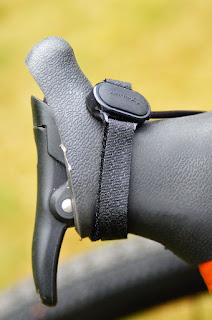Having celebrated my birthday, complete
with homemade cake and Chapattis the customary week later, a fresh box of
winter kit arrived, including these lobster mitts from a well-known discount
supermarket chain. Supposedly wind and waterproof, sheer purchase power means
that prices are falling while performance and spec continue to rise.
Vaguely reminiscent of mittens that
some of us were packed off to primary school with, warmth is their main
attraction. Dexterity is better than I’d initially predicted too. Thumb and two
fingers are nimble enough for gripping bars, changing gear, grabbing bottles
and even drinking coffee.
Communication with touch screen tech is
something we take for granted; thankfully the fore-finger makes accurate
contact. Traditionally, this design has necessitated removal, say when fixing a
flat, or rummaging in pockets for keys. The last thing you want when it’s minus
five and you’re ten miles from home.
I’ve been able to remove wheels, wield
a tyre lever or multi-tool with surprising finesse, although thankfully, the
former scenario hasn’t been to frequent. (leaving my blue/grey fixer on
the work stand and at a sensible height seems to have deterred feline attack
too). Another chain has sent their top-flight sub £20 set, which look very
promising.
As with other garments, especially
those made from polyester/polyamide blends; there is a trade-off between
weatherproofing and breathability. Personally something highly weather
resistant and fast wicking over something “totally impervious” that turns
uncomfortably clammy over relatively short periods-even when air temperatures
struggle into single figures.
Ensure cuffs are long enough to form an
overlapping seal with training jackets and jerseys. An impervious glove is not
much use if there’s a gap for wind, rain or snow to get channelled inside. For
this reason, gender specific versions are best. A surprising number of female
riders I’ve spoken with in casual conversation suggest they get along just fine
with men’s kit.
Gender specific designs are arguably
best; so long as these are genuinely anatomically designed, rather than smaller
versions of the standard pattern. By men’s standards, my wrists are relatively
thin and fingers proportionally longer. These days, I can usually compromise a
decent fit with most brands’ large size.
Linings shouldn’t be overlooked either.
Check these are tethered at the fingers. This doesn’t tend to prove problematic
until wash day. Those that aren’t tend to flop out in a big, soggy clump.
Persuading them back into individual fingers can prove frustrating.
Continuing the cold theme, local
authorities have been out gritting some of the minor roads recently, pelting
Univega and I with those tiny, corrosive particles. To date, the weather has
been sufficiently dry enough for green oil’s dry chain lube, which is clean and
light; though I will probably strip this in favour of its wet counterpart; or
something in between as the roads get carpeted in a slimy cocktail.
Perfect conditions for assessing Pro
Green MX’s Cycle Aftershine101’s performance; to date, it hasn’t attracted that
familiar grimy patina, which I associate with silicone infused polishes/protectant.
I’m curious to see how the protective
barrier stands up to salt and similar corrosive spatter consistent with regular
winter riding over the following weeks. Obviously, these are no substitutes for
owner involvement. Ideally bikes should be rinsed off with cold water following
each salty, slushy ride-it only takes a few minutes.
Storing bikes in cold garages or
outbuildings also helps slow the caustic chemical reaction. I tend to wash my
cross and other dirt derived builds straight afterward in any case, but if
you’re about to head out for a cold, icy ride, leaving your machine(s) outside
for fifteen minutes allows them to acclimatise and means sleet, snow, slush and
similar contaminants find it harder to stick...
Shoes and clothing also take a beating,
so remember to rinse them off and air dry at room temperature, away from
radiators and other sources of heat. So long as the comfort is right, budget
tights and winter weight jerseys are among my staples for everyday
rides/training around the two hour mark. Right, time I was getting some
more miles in and forming opinions. Look out for a winter clothing overview in
Seven Day Cyclist www.sevendaycyclist.com















































